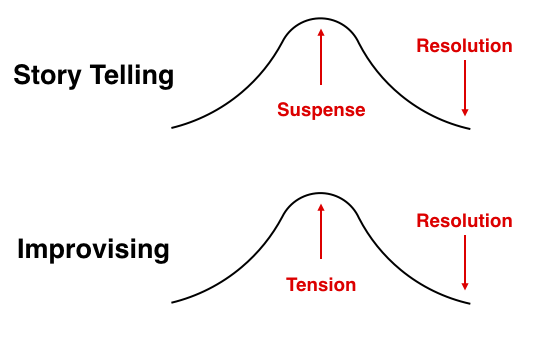Misconceptions
There are two common misconceptions about improvisation, they are:
- Creativity can’t be learned; and
- Improvisation is improvised.
Both are completely wrong. Improvisation can be learned and actually requires lots of practice and planning (I will expand on this in the lesson on Chord Mapping).
Jazz Improvisation
The single overarching idea behind all Jazz improvisation is that of Creating and Resolving Tension. This is absolutely essential for Jazz improvisation. ‘Tension’ is just another word for ‘dissonance’.
- You create tension by playing ‘outside’ (playing ‘wrong’ notes)
- You resolve tension by playing ‘inside’ (playing ‘right’ notes).
Tension should rise and fall like a wave during a Jazz solo. You build tension (just like building suspense in a story) by playing jarring notes and intervals that clash with the chords, before resolving the tension (resolving the suspense) by playing smooth and consonant notes and intervals that complement the chords. An improvisation that does not build and resolve tension is not a Jazz improvisation.

In the previous module we learned numerous Jazz Scales. We discussed how they are derived; what notes they are comprised of; and what chords you can use them over. This all related to playing ‘inside’ – that is, playing scales that sound ‘good’ over a particular chord.
- For example, playing a C Lydian scale over a CMaj7 chord will sound ‘good’ and have very little ‘tension’.
But in Jazz improvisation we also need to create tension by playing ‘outside’. This means either playing ‘wrong’ scales (say, D♭ Lydian over CMaj7) or wrong notes (say, F [an avoid note] or A♭ over CMaj7).
So in a sense, Jazz Improvisation is really just a process of combining:
- Outside notes – to create tension; and
- Inside notes – to resolve tension.
Now, of course, playing ‘wrong’ notes is easy. You can just mash your palm on the piano (which is a technique called Tone Clusters, by the way…). But the challenge of playing ‘wrong’ notes is to be able to resolve them to ‘right’ notes in such a way as to make the whole phrase sound ‘good’ (whatever that means…). Two quotes are worth sharing here:
- “There are no wrong notes, only wrong resolutions” ~ Bill Evans
- “It’s not the note you play that’s the wrong note – it’s the note you play afterwards that makes it right or wrong.” ~ Miles Davis
You need to create tension by using ‘outside’ or ‘wrong’ notes and then resolve that tension artfully by falling back onto the ‘inside’ or ‘right’ notes. But, rather strangely, there are ‘right’ ways of playing ‘wrong’ notes. While you can just play wrong notes at random, it’s generally better to play them in a structured way. There are numerous ways of doing this, and I’ve listed some of the techniques below. The rest of this module will be covering these improvisation techniques.
Creating and Resolving Tension
Ways you can create tension:
- Scales
- Polytonality
- Ambiguous
- Passing Notes (Approach Note/Targeting)
- Cycled Patterns
- Dissonant intervals
- Avoid notes
- Displacing the Melody
- Chord Extensions
Ways you can resolve tension:
- Riffs
- Scales
- Diatonic
- Arpeggios
- Guide Tones
- Melody
- Quotes & Cliches